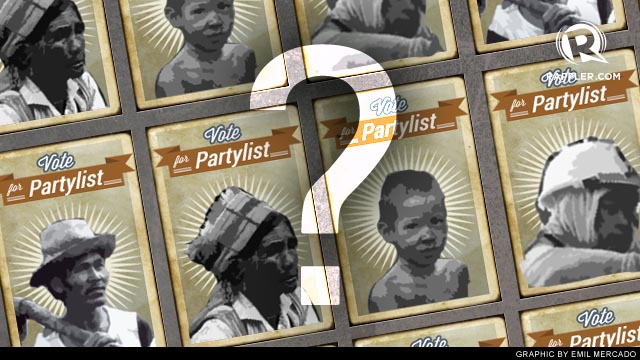SUMMARY
This is AI generated summarization, which may have errors. For context, always refer to the full article.

MANILA, Philippines – The 2013 polls will be the sixth time that Filipinos will be voting congressional representatives through the party list. Yet, many voters don’t have a clear understanding of what it is about, or how they should go about it.
Contributing to the low awareness of – even little interest in – the party list is the confusion caused by the conflicting interpretations that the Commission on Elections (Comelec) and the Supreme Court have of the Constitution and the Party List System Act (Republic Act 7941), causing changes in the rules every election.
In 2013, these are the things you should know before casting your vote for the party list:
1. You are voting for a party or organization, not a person.
A party or organization, upon applying for accreditation with the Comelec, also submitted a list of up to 5 nominees. If the party or group wins, the first nominee becomes the congressman. If the group wins another seat, the second nominee becomes congressman too.
2. You are voting for only one party or organization.
Although there are 58 seats available for the party list (the Constitution mandates that 20% of the total number of seats in the House of Representatives will be for the party list), you are not voting for as many groups. Of the 136 parties and organizations vying, you can only vote for one. If you shade the oval across more than one group, the counting machine will void the party list portion of your ballot.
3. What are the parties and organizations participating in the party list in 2013?
According to RA 7941, any national, regional, or sectoral party or coalition may join once accredited by the Comelec. Banned from the party list are groups that are religious, advocate violence and other illegal ways in its advocacy, and are foreign or foreign-funded.
Click below to enlarge the image of the official 2013 ballot’s party list portion.
4. Remember your choice group’s number on the ballot.
This is the first time that parties and organizations in the party list are not listed alphabetically on the ballot. They are arranged randomly. The Comelec under chairman Sixto Brillantes Jr introduced this rule to remove the advantage that groups with names starting with “A” or “1” used to enjoy.
So, with 136 listed, how can you easily find your preferred group? This early, check out the official ballot template above or the campaign paraphernalia of your preferred organization, where they indicate what’s the number assigned to them in the ballot. On Election Day, when you get to the party list portion of your ballot, go straight to that number.
5. While you won’t be voting for persons, you have a way of checking who are the nominees of the different groups.
A party-list nominee must be: a natural-born citizen of the Philippines, a registered voter, residing in the country at least a year before election day, literate, a bona fide member of the party nominating him or her at least 90 days before the elections, and at least 25 years old on election day.
Click on the image below to know the first 3 nominees of each group participating in the party list. Under the rules, a group has to submit 5 nominees, but can get a maximum of only 3 seats. The extra nominees can assume the posts in the event that the first nominees are unable to occupy them.
6. Your preferred group’s chances of winning will depend on the percentage it gets against the total votes for all the participating groups.
The party list is a system of proportional representation – the number of seats that an organization can win will be determined by the percentage of votes it will get against the total votes cast for all 136 groups. The 58 seats therefore don’t automatically go to the 58 groups with the highest number of votes.
Based on the formula most recently revised by the Supreme Court, each group that gets 2% of the total party-list votes will get a seat each – their No. 1 nominee will become congressman. After all the “2-percenters” get a seat each, what remains of the 58 seats will be distributed among those that got more than 2%, paving the way for a group’s nominees No. 2 and No. 3 to become congressmen.
7. You will still vote for a district representative (congressman), on the opposite side of the ballot.
The party list portion is on the same side of the ballot as the senatorial portion, because both positions are elected nationally, although a winning party-list group’s nominee sits in the House of Representatives.
On the other side of the ballot are the candidates for local positions, where you will find your choices for representatives of geo-political districts.
8. Your party-list representative is not a second-class congressman.
The nominee of a winning party-list organization will have the same responsibilities, powers, and benefits as the congressmen elected from the districts. They can sponsor bills, head committees, call investigations in aid of legislation, receive equal amounts of pork barrel, and, yes, drive around with an “8” for their car plate. – with Angela Casauay/Rappler.com
Add a comment
How does this make you feel?
There are no comments yet. Add your comment to start the conversation.